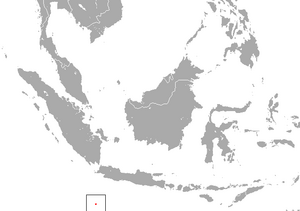Christmas Island shrew facts for kids
Quick facts for kids Christmas Island shrew |
|
|---|---|
| Conservation status | |
| Scientific classification | |
| Genus: |
Crocidura
|
| Species: |
trichura
|
 |
|
| Christmas Island shrew range | |
| Synonyms | |
|
Crocidura fuliginosa trichura |
|
The Christmas Island shrew (Crocidura trichura) is a very rare animal. It might even be extinct! This tiny creature lives on Christmas Island, a small island in the Indian Ocean. It's a type of shrew, which is a small mammal that looks a bit like a mouse.
Scientists once thought this shrew was a subspecies of other shrews. But now they believe it is its own unique species. This is because it looks different and lives very far away from those other shrews.
Contents
What is the Christmas Island Shrew?
The Christmas Island shrew is a small mammal. It has short legs and a pointed nose, like other shrews. Its fur can be dark gray or reddish-brown.
This shrew looks a lot like a mouse. It weighs about 4.5 to 6 grams. That's about the same as a few paperclips! What makes this shrew special are its long, fine hairs and a very long tail. Most shrews live for about one year. Some have been known to live up to two years in the wild.
Where Does It Live?
The Christmas Island shrew lives on the ground. It prefers tall rainforests with deep soil. It also lives in rainforests with shallow soil. We don't know if it can live in areas where forests have grown back after being cut down.
This shrew mostly eats small beetles. It finds shelter in holes in rocks and tree roots.
Is It Still Alive?
The last time scientists definitely saw a Christmas Island shrew was in 1985. They caught two of them, but both later died. Fifteen years later, in 2000, a search found no shrews at all.
Because of this, the Christmas Island shrew is listed as critically endangered. This means it is very close to disappearing forever. It might even be extinct already.
Why Is It Endangered?
The number of Christmas Island shrews has dropped a lot since the year 1900. We don't know the exact reason why. After the 1985 sightings, there were a few unconfirmed reports between 1996 and 1998. But the 2000 survey found nothing.
Many things might have caused their numbers to fall. These include diseases and losing their homes. Invasive weeds can also change their habitat. Other animals like cats and black rats might also hunt them. Having a very small population makes them more vulnerable. Also, shrews can get hit by cars on roads.
One big problem might be the yellow crazy ant (Anoplolepis gracilipes). These ants were accidentally brought to Christmas Island. They are very dangerous to many ground animals there.
Disease from Rats
One idea is that a disease caused the shrews to disappear. This disease is called trypanosoma. It is carried by black rats, which were brought to the island. This disease is also thought to have caused two types of native rats to become extinct.
The shrew's population started to drop around the same time black rats arrived. These rats carried a parasite. However, scientists are not completely sure if the black rat or this parasite caused the shrew's decline.
Competition with Red Crabs
Another idea involves the Christmas Island red crab (Gecarcoidea natalis). When the native rats disappeared, the red crab population grew very fast. Red crabs usually were food for the rats.
These crabs might have competed with the shrews for food and shelter. This could have forced the shrews to move to new places, like tree branches. Young shrews might have been very vulnerable. They leave their nests early and wander around, making them easy prey for the many crabs.
How Can We Help?
The Australian Government has a plan to help the Christmas Island shrew. It has two main stages:
Stage 1:
- Find out exactly what type of shrew it is.
- Learn how many shrews are left and where they live.
- Create a plan to manage their habitat.
- Control the number of Yellow Crazy Ants.
- Start programs to help people find new shrew populations.
Stage 2:
- Start breeding shrews in captivity if any are found.
- Protect and manage the wild shrew population.
- Find and protect the most important habitats for shrews. This includes places for shelter, breeding, and finding food.
- Figure out what threats are harming the shrews and stop them.
The Australian Government believes that stopping the Yellow Crazy Ant is very important. These ants are very harmful to Christmas Island's ecosystem. They kill land crabs, native reptiles, and many insects. Yellow Crazy Ants are a danger to all mammals, birds, and reptiles on the island. They either hunt these animals or destroy their food and homes. This leads to many animals dying.
See also
 In Spanish: Musaraña de la Isla de Navidad para niños
In Spanish: Musaraña de la Isla de Navidad para niños


